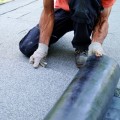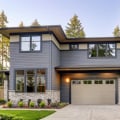Flat roofs are a popular choice for commercial properties, but they come with their own set of problems. Asphalt, shingles, and other surfaces are porous, increasing the chance of leaks, mold, and moisture damage if roof drainage is poor. However, a waterproof sealant can protect your roof. In fact, many flat roofs are sealed with water-resistant coatings.
For your convenience, we've compiled a list of the 6 most common flat roof problems and how best to deal with them, depending on their severity. One of the most prominent signs that your flat roof needs to be replaced is the formation of alligators. The alligator is produced when the asphalt used to build the flat roof has aged and lost elasticity, causing it to crack and bubble and look like the skin of an alligator. Like most other materials, flat asphalt roofs tend to expand and contract with changing weather and temperatures.
Over time, this continuous expansion and contraction can cause the joint stopper to separate from the edges and corners of the roof, resulting in leaks and moisture that can be trapped inside the roof. If you have questions about the condition of your flat roof or think it's time for an inspection, contact a professional roofer. Cracks can occur in a flat roof for a variety of reasons, such as the accumulation of water, the formation of blisters, thermal movement or bending of the roof. Without regular maintenance, water will pass through these cracks and damage the interior of the building over time.
Just as water doesn't drain from a flat roof as easily as it does from a sloped roof, flat roofs are more prone to debris accumulation. With a sloped roof, leaves, pine needles, branches, and other objects are more likely to slip off. On a flat roof, they are more likely to sit there. Debris accumulation can degrade roof materials, exert excessive pressure on the roof structure, cause water accumulations and leaks, clog drains and vents.
Flat roofs must be cleaned of debris regularly. This can be done with a broom or a blower. You may also want to pressure wash the ceiling to help remove more persistent dirt. In addition to performing annual maintenance, you should check your roof seasonally - especially during fall when leaves and branches are more likely to fall on the roof - and inspect it for debris accumulation on a quarterly basis.
Blistering can be caused by many problems such as water accumulation on the roof, poor drainage, debris buildup, poor ventilation or installation errors. The occasional appearance of small blisters is not necessarily a sign that you need to replace the roof; however if you see blisters you should keep an eye on them and schedule an inspection with a professional roofer. The lack of slope allows leaves branches and other debris to accumulate more easily on a flat roof and block drainage. In addition a large pile of uncleaned leaves retains moisture that can freeze thaw and refreeze during winter.
This cycle will wreak havoc on the roof below. Yes “alligator” is a real term; it refers to a flat roof that has started to crack and bubble similar to the skin of an alligator. Usually exposure to sun over time is cause of this problem and you can't turn off sun completely. If left untreated a flat alligator-shaped roof can lead to more cracks leaks inside house and total failure of roofing system.
Homes settle down and change over time; as result so does membrane between house and roofing material. Because membrane of flat roof is continuous sheet this displacement can cause it to bend. A poorly installed flat roof can also contribute to it bending which can also lead to greater problems and possibly require replacement sooner rather than later. Roofs must be able withstand elements especially wind; if one or two tiles come off conventional roof although this is not ideal rest of tiles are designed withstand all but most windy conditions.
Because flat roofs are sheet material little wind damage can turn into lot wind damage with just few extra gusts; entire roof can fail and require immediate replacement. Stagnant water alligators waves natural elements can all contribute to flat roof leaking; however leaks can still occur without these problems. For example damaged gasket cover can just as easily cause leaks on flat roof as on sloped one; poor installation substandard materials or simple age can also cause flat roof leaks. After expert installation flat roofs should last minimum 15 years maybe up 30 years; overall it's shorter lifespan than asphalt shingle one much less than cedar metal roofs; new owners existing homes who are unsure how old their flat roofs are should anticipate that replacement will not occur distant future. Flat roofs are practical option for commercial properties; these roofs may be best choice for large structures provide useful space for HVAC or refrigeration equipment; they are easier access than steeper sloped ones which is important because this type requires frequent inspection maintenance mitigate prevent following problems which can shorten lifespan require commercial replacement sooner rather than later. Roofing specialists make adjustments promote drainage prevent waterlogging persistent build-up may require replacement...



